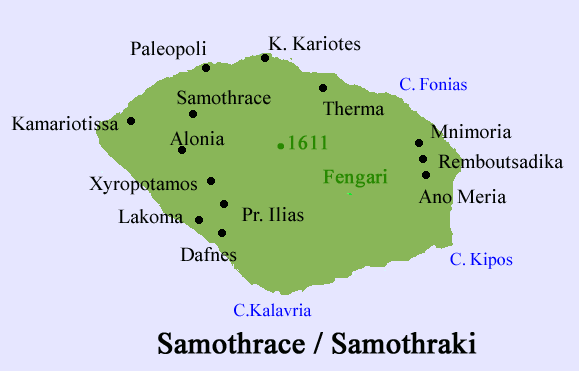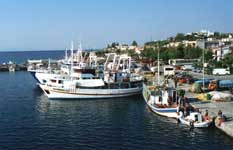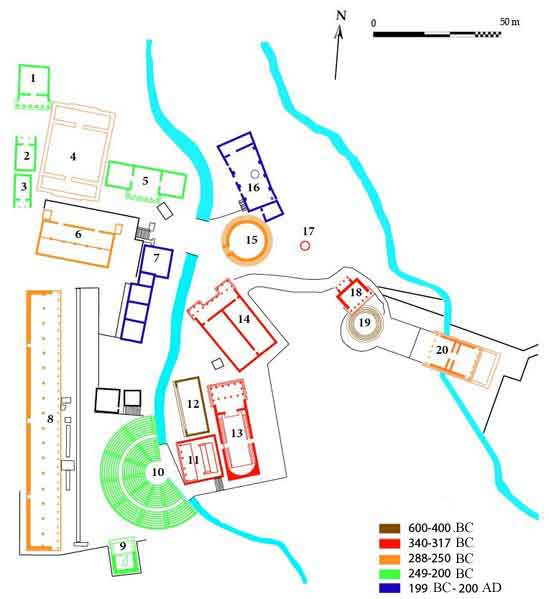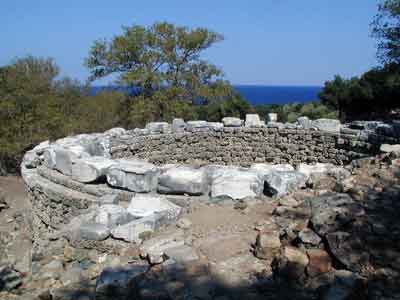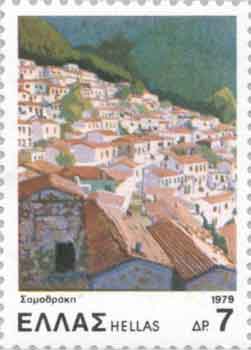|
|
Samothrace, Google Earth
Samothrace (in Greek: Σαμοθρακη, Samothraki) is an island in Greece, in the northern Aegean Sea. It is a self-governing deme in the district of Evros in the province of East Macedonia and Thrace. It is only a few kilometres west of the maritime boundary between Greece and Turkey. The island is 178 square kilometres in size and has a population of about 2.723 (2001) Its main industries are fishing and tourism. Samothrace was not a state of any political significance in ancient Greece, since it has no natural harbour and most of the island is too mountainous for cultivation: Oros Fengari (Mount Moon) rises to 1,624 metres. It was, however, the home of the Sanctuary of the Great Gods, site of important Hellenic and pre-Hellenic religious ceremonies. Among those who visited this shrine to be initiated into the island cult were King Lysander of Sparta, Philip II of Macedon and Cornelius Piso, father-in-law of Julius Caesar.
Samothrace (Source) Samothrace was part of the Athenian Empire in the 5th century BC, and then passed successively through Macedonian, Roman, Byzantine and Ottoman rule before being returned to Greek rule in 1913 following the Balkan War. It was occupied by Bulgaria during the Second World War.
Samothrace sancturary plan (Source)
Hieron (plan 13) in Samothrace with five columns restored, in the mysteries of the Kabeiroi sancturary [Source]
Arsinoe's rotunda in Samothrace , dedicated to the gods by Arsinoe II of Egypt, wife of Lysimachus (Plan number 15) [Source] . The Rotunda is the largest closed, round building known from Greek architecture. ReconstructionArsinóeion, Arsinoe II, Samothrace, August 2001 [Source] See :Karl Lehmann , Samothrace, Volume 7: The Rotunda of Arsinoe, 1992 , Princeton University Press ; ISBN: 0691099197 The ancient city, the ruins of which are called Palaeopoli ("old city"), was situated on the north coast. Considerable remains still exist of the ancient walls, which were built in massive Cyclopean style, as well as of the Sanctuary of the Great Gods, where mysterious rites took place which were open to both slaves and free people (in contrast to the Eleusinian Mysteries).
The modern port town of Kamariotissa is on the north-west coast and provides ferry access to and from points in northern Greece such as Alexandroupoli and Kavala. There is no commercial airport on the island. Other sites of interest on the island include the ruins of Genoese forts, the picturesque hora (old town), and several waterfalls.
The island's most famous artistic treasure is the 2.5-metre marble statue of Nike, now known as the Winged Victory of Samothrace, dating from about 190 BC. It was discovered in pieces on the island in 1863 by the French archaeologist Charles Champoiseau, and is now in the Louvre in Paris. The population of Samothraki was 2723 in 2001 :
Archaeological Museum of Samothrace Links
Retrieved from "http://en.wikipedia.org/"
 |
|
|||||||||||||
|
|
